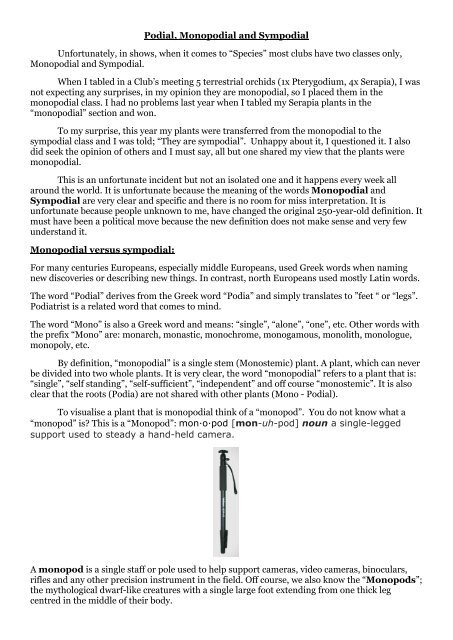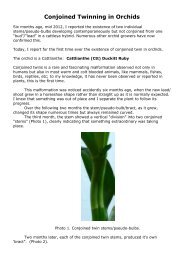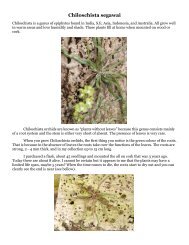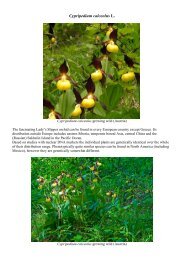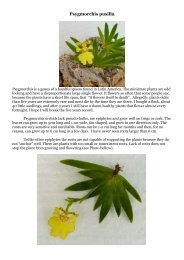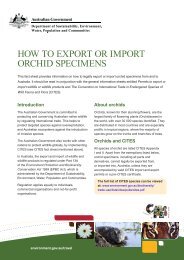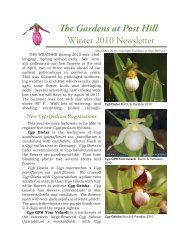P + M + S - Orchids-World
P + M + S - Orchids-World
P + M + S - Orchids-World
Create successful ePaper yourself
Turn your PDF publications into a flip-book with our unique Google optimized e-Paper software.
Podial, Monopodial and Sympodial<br />
Unfortunately, in shows, when it comes to “Species” most clubs have two classes only,<br />
Monopodial and Sympodial.<br />
When I tabled in a Club’s meeting 5 terrestrial orchids (1x Pterygodium, 4x Serapia), I was<br />
not expecting any surprises, in my opinion they are monopodial, so I placed them in the<br />
monopodial class. I had no problems last year when I tabled my Serapia plants in the<br />
“monopodial” section and won.<br />
To my surprise, this year my plants were transferred from the monopodial to the<br />
sympodial class and I was told; “They are sympodial”. Unhappy about it, I questioned it. I also<br />
did seek the opinion of others and I must say, all but one shared my view that the plants were<br />
monopodial.<br />
This is an unfortunate incident but not an isolated one and it happens every week all<br />
around the world. It is unfortunate because the meaning of the words Monopodial and<br />
Sympodial are very clear and specific and there is no room for miss interpretation. It is<br />
unfortunate because people unknown to me, have changed the original 250-year-old definition. It<br />
must have been a political move because the new definition does not make sense and very few<br />
understand it.<br />
Monopodial versus sympodial:<br />
For many centuries Europeans, especially middle Europeans, used Greek words when naming<br />
new discoveries or describing new things. In contrast, north Europeans used mostly Latin words.<br />
The word “Podial” derives from the Greek word “Podia” and simply translates to ”feet “ or “legs”.<br />
Podiatrist is a related word that comes to mind.<br />
The word “Mono” is also a Greek word and means: “single”, “alone”, “one”, etc. Other words with<br />
the prefix “Mono” are: monarch, monastic, monochrome, monogamous, monolith, monologue,<br />
monopoly, etc.<br />
By definition, “monopodial” is a single stem (Monostemic) plant. A plant, which can never<br />
be divided into two whole plants. It is very clear, the word “monopodial” refers to a plant that is:<br />
“single”, “self standing”, “self-sufficient”, “independent” and off course “monostemic”. It is also<br />
clear that the roots (Podia) are not shared with other plants (Mono - Podial).<br />
To visualise a plant that is monopodial think of a “monopod”. You do not know what a<br />
“monopod” is? This is a “Monopod”: mon·o·pod [mon-uh-pod] noun a single-legged<br />
support used to steady a hand-held camera.<br />
A monopod is a single staff or pole used to help support cameras, video cameras, binoculars,<br />
rifles and any other precision instrument in the field. Off course, we also know the “Monopods”;<br />
the mythological dwarf-like creatures with a single large foot extending from one thick leg<br />
centred in the middle of their body.
From the above, it is very clear that the definition on “Monopod” and therefore “Monopodial” is<br />
very clear and specific. It is also very clear that the name refers to the appearance and when it<br />
comes to orchids, it does not in any way differentiate between terrestrials and epiphytes, annuals<br />
and evergreens, plants that grow from seed, cuttings or tubers. It is an ill-conceived idea that<br />
orchids with limited life span (annuals) cannot be monopodial.<br />
“Sym” is also a Greek word, a very confusing one. It is meaningless when used alone and<br />
has numerous interpretations when added to other words, as a prefix, for example: “joint”,<br />
“together”, “with”, “sharing”, etc. Words using “Sym” as a prefix are: Symbiotic, Symbolic,<br />
Symmetric, Sympathetic, Symphony, Symposium, Symptoms, etc. By definition, the word<br />
“sympodial” implies that a plant, given time, will develop into a large inter- connected, selfsupporting<br />
specimen. A specimen made up from growths of many generations all sharing the<br />
same roots, “living together” and “supporting each other”.<br />
When it comes to the definition of “sympodial”, it is almost certain that it was based on<br />
orchids not found in Europe like cattleya and catasetum. New genera were added but the<br />
definition did not change much the last 250 years.<br />
The definition “Monopodial” was probably based on terrestrial orchids found in Europe,<br />
like Ophrys, Orchis, Satyrion, etc. The definition has changed substantially to represent<br />
exclusively the vandaceous orchids. Practically, today we have two groups: Vandaceous and Non-<br />
Vandaceous. The words "monopodial" and "sympodial" are still being used; however, they have<br />
no real meaning simply because vandaceous plants are not necessarily monopodial and many<br />
non-vandaceous plants are in fact monopodial.<br />
Podial, Monopodial and Sympodial: The author’s point of View.<br />
Facts of life:<br />
All life forms are born to multiply and die. Nothing lives forever.<br />
Today’s definition of “monopodial” plants claims that monopodial plants grow forever.<br />
That is a scientifically not sound argument.<br />
All plants grow upright because plants need light.<br />
Another claim is that monopodial orchids grow upright. That is silly because it suggests<br />
that sympodial orchids do not. All plants grow upright and nothing lives forever.<br />
The true difference between a monopodial and sympodial is simple. Sympodial plants can<br />
be divided into two or more healthy independent plants, each sharing a part of the original root<br />
system and capable of surviving if planted separately. Monopodial plants, being “single stem”<br />
plants (monostemic), cannot be divided.<br />
The majority of orchids are sympodial; however, there are many genera that are<br />
monopodial and there are also orchids that are neither monopodial nor sympodial; I call them<br />
“Podial”.<br />
Podial are orchids that have no visible stems or leaves, only roots; Just legs = “Podia”.<br />
Today, this “podial” group of orchids, because of there are classified as Vandaceous, are listed as<br />
Monopodial. I hope the name will be adopted soon or later officially.<br />
Sympodial: For an orchid to be sympodial it must satisfy at least 3 main criteria if not all four.<br />
1. New growths are part of the main plant and are either attached to the main<br />
body or to the pseudo-bulbs or to bulbs. The number of new growths is NOT<br />
limited to one. Some pseudo-bulbs can produce 2-3 new growths<br />
simultaneously.<br />
2. Pseudo-bulbs, bulbs and roots are interconnected and continue to support<br />
the new growth(s) for the life of the plant.<br />
3. Sympodial orchids can be propagated by seed, division, cuttings, keikis and<br />
almost all genera can be mericloned.
4. Some genera produce keikis (young plants). These keikis can be attached to a<br />
flower spike, a runner, a pseudo-bulbs or a leave. <strong>Orchids</strong> with keikis are<br />
sympodial.<br />
Monopodial: “Monopodial” orchids have their own characteristics.<br />
1. Only Single Stem (Monostemic) plants can be Monopodial.<br />
2. Monopodial orchids, being single stem plants, do not share their root system<br />
with other “suckers” or “stems”.<br />
3. Monopodial orchids grow upwards only but “branching” can occur. Branches<br />
do not have roots at the point of branching, like keikis do.<br />
4. Monopodial orchids can only be propagated by seed, tubers, cuttings or<br />
mericloning.<br />
Podial: Podial orchids have their own characteristics and are very easy to recognise.<br />
1. Podial orchids are just a bunch of roots that contain chlorophyll and have<br />
taken over the function of the leaves.<br />
2. Can only be grown from seed and cannot be propagated in any other way.<br />
3. Have no visible stem and rarely have leaves. Only young seedlings may have<br />
leaves.<br />
Species of the genus Chiloschista are typical representatives of this group.<br />
You may ask. Why Vandaceous plants are classified as “monopodial”?<br />
That’s something of a mystery to me that I cannot explain. Most Vandaceous plants are in fact<br />
“sympodial”. Every claim made about vandaceous plants can be rebutted. The tallest<br />
unsupported orchids are Dendrobiums; the claim that Vandaceous orchids do not have terminal<br />
flowers spikes is not true (V. merrillii); the claim that Vandaceous plants grow upwards (upright)<br />
or grow forever is not true. Many vandaceous plants are planted in baskets because the branches<br />
grow “downwards” (hanging down). For example: Species of the Genus: Cleisostoma.<br />
Examples:<br />
Sarcochilus: Clearly a “Sympodial” Orchid of the Vanda family. Large specimens have multiple<br />
stems with roots that support new and old stems. The plants are spreading sideways and can<br />
form very large specimens. Sarcochilus can be propagated by division.<br />
Ascocentrum miniatum. Large specimens can be seen in shows all over the world. The<br />
numerous flower spikes, grown from numerous stems, all connected at the basis, all using the<br />
existing root system, etc. Ascocentrum can be propagated by division.<br />
Phalaenopsis: Typical “sympodial” orchids: They grow upright but spreading sideways like<br />
strawberries do, by producing runners with “keikis”. Other orchid genera that do the same are:<br />
Dendrobiums, Epidendrums, Oncidiums, Brassias, Phragmipediums, Pleurothallid Alliance<br />
(Stellis, Pleuropthallis, Restrepia, etc.), etc. ALL SYMPODIAL. As the saying goes: If it walks<br />
like a duck, quacks like a duck, lay eggs like a duck, is a duck.<br />
What very few people realise is that Keikis make it possible for Phalenopsis to propagate itself by<br />
division. Phalenopsis species can produce up to 10 or more keikis at any given time. The parent<br />
plant supports these “babies” for a considerable time until they produce their own aerial roots<br />
and can partly support themselves. Most keikis unable to find and attach themselves on branches<br />
touch the ground and start a new life. Runners run parallel to the ground, like strawberries do<br />
and keikis touch the ground faster. In the mean time the keikis continue to use the roots of the
mother plant for support. In nature, in most cases the “mother plant” in its effort to support its<br />
own offspring (keikis) soon or later will die. It fulfilled the purpose of a life form: Born – Multiply<br />
– Die.<br />
There are hundreds of other examples.<br />
The two terrestrials I mentioned at the beginning are Serapia and Pterygodium. Other similar<br />
genera are: Pterostylis, Diuris, Thelymitra, Leptoceras, Corybas, etc. In all these orchids:<br />
1. One little tuber produces one single self-standing, self-sufficient plant, never<br />
two. (Monostemic)<br />
2. The plant will die slowly after flowering and in most cases the tuber will<br />
shrivel and die.<br />
3. The roots MAY form one or more tubers. These tubers are not connected to<br />
the main tuber and therefore to the plant it self and are not capable of<br />
producing a “shoot” straight away (the same year).<br />
4. The string-like root that connects the new tubers will die during the dormant<br />
period and the tubers will also mature during that time.<br />
5. When the new growth season starts autumn or spring, the now independent<br />
tubers will produce a single plant each.<br />
6. Each plant will be on its own, have its own root system, etc. (New life cycle)<br />
These orchids fulfil the requirements of a monopodial plant and were monopodial 250 years ago.<br />
Today, they are sympodial because they are annuals and because the flower spike is terminal.<br />
Off course, there are terrestrial orchids like Eulophia that are sympodial. They have<br />
pseudo-bulbs and not tubers. The pseudo-bulbs are in some species visible above the ground and<br />
other species hidden underground. They grow the same way sympodial orchids grow. New<br />
pseudo-bulbs are attached to existing older pseudo-bulbs and continue to feed and receive<br />
support from them. These orchids can be propagated by division.<br />
Isn’t it time to say what we mean and mean what we say?<br />
Dr. George Tsambourakis,<br />
Gold Coast, Queensland, Australia.


